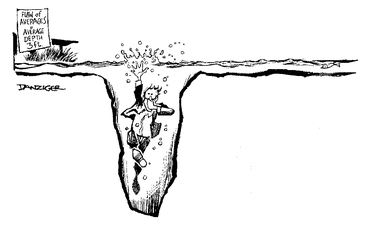CHAPTER 1
The Flaw of Averages
Our culture encodes a strong bias either to neglect or ignore variation. We tend to focus instead on measures of central tendency, and as a result we make some terrible mistakes, often with considerable practical import.
—Stephen Jay Gould, naturalist, 1941-2002
The measure of central tendency that Gould refers to is typically the
average, also known as the
expected value, and the mistakes he warns of result from a common fallacy as fundamental as the belief that the earth is flat. It permeates planning activities in business, government, and the military. It helped mask the recent subprime mortgage fiasco until it became a world crisis, and it will plague those trying to clean up the mess. It is even enshrined within our accounting codes. I call it the Flaw of Averages.
1,
2 It states, in effect, that:
Plans based on average assumptions are wrong on average.
An apocryphal example concerns the statistician who drowned while fording a river that was, on average, only three feet deep, as depicted in the sensitive portrayal by cartoonist Jeff Danziger.
In everyday life, the Flaw of Averages ensures that plans based on average customer demand, average completion time, average interest rate, and other uncertainties are below projection, behind schedule, and beyond budget.
So people have been confused in the face of uncertainty for 2,000 years. What else ...


